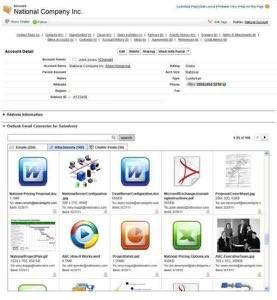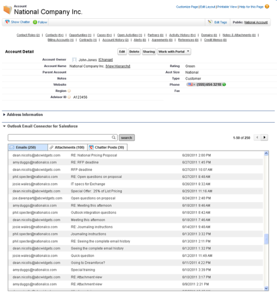In a number of important regards, this headline is surprisingly quite accurate. The typical concept of a Salesforce connector for Microsoft Outlook is something that integrates Chatter, events, and pertinent messages into the familiar Outlook front-end. This is not at all what LiveOffice has made, and from its vantage point, this isn’t even what customers may want.

No, what LiveOffice (whose principal product is an e-mail archiving system) premiered at Salesforce this week is, from a technical standpoint, more like an e-mail reflector – the kind that folks used with BlackBerry back when folks used BlackBerrys – which makes e-mails and attachments from Outlook viewable and manageable within Salesforce.com.
“These plug-ins suffer from the fact that, first of all, they’re plug-ins,” says Dean Nicolls, LiveOffice vice president of marketing, in an interview with RWW. “Plug-ins by their nature have all kinds of IT problems, and IT has to manage those plug-ins at the desktop level. They have to make sure they’re actually deployed across all the users within an organization, and they have to hope and pray that users actually use the plug-in when they record their e-mail history. We both know that actually doesn’t happen.”

LiveOffice’s Outlook Email Connector, despite its title, is actually an extension of the e-mail archiving service it has already deployed, but devised in a clever way to make e-mails elements of the Salesforce environment. It does not replace Outlook, nor does it make Salesforce into an e-mail composition program. You still run Outlook to manage all the client-side rules, as well as to communicate with Exchange.
Then LiveOffice archives your Outlook inbox just as it does for other customers. It then indexes that archive, and presents a view of that index inside Salesforce.
“Salespeople don’t want to take the time to record three or four extra clicks using a plug-in to associate an e-mail with the right contact within Salesforce,” Nicolls explains. They also don’t want to deal with the frequent slowdowns and crashes that Outlook plug-ins create – or, more accurately, with the IT department upon whose shoulders the job of fixing these crashes will eventually rest.
“By leveraging journaling, we have an archive that’s sitting in the cloud; and then through APIs, we then paint that archive inside of Salesforce so that, if you’re looking at a given opportunity or a given contact, you can see the entire history right there at your fingertips,” he adds.

The LiveOffice service indexes everything, Nicolls points out, including the contents of the most common attachment file types – Microsoft Word, Excel, and PowerPoint, and PDF files – plus every Salesforce Chatter post. An exclusive search box inside the Connector gives users the means to find included information, by means of the live index.
This frees users, he says, from having to record extra information separately. “Because you’re using journaling, all of that information gets captured inside the archive, so there’s no user clicks, and there’s nothing for IT to manage. A lot of its burden is lifted as well. And it doesn’t impact Outlook at all, nor [anything else] at the Exchange level.”
Salesforce.com normally offers 600 MB per user for file storage. “That may seem like a lot, but if you send out five to ten megs of attachments per day, you’re going to burn through that storage in about four months. Then you’re going to end up paying something on the order of $1,000 – 1,500 per user just in storage fees. Our model is based on unlimited storage and unlimited retention, and all those e-mails are being stored inside our cloud. So you don’t have to pay any of these storage fees.”
LiveOffice will offer Outlook E-mail Connector free for a limited time to charter subscribers, in a deal that includes unlimited storage. Nicolls tells RWW that the company will probably start charging for Connector sometime in Q4.










